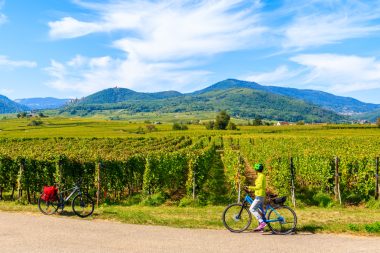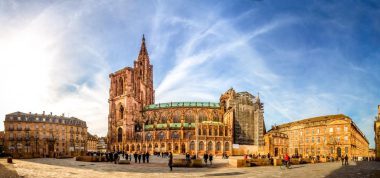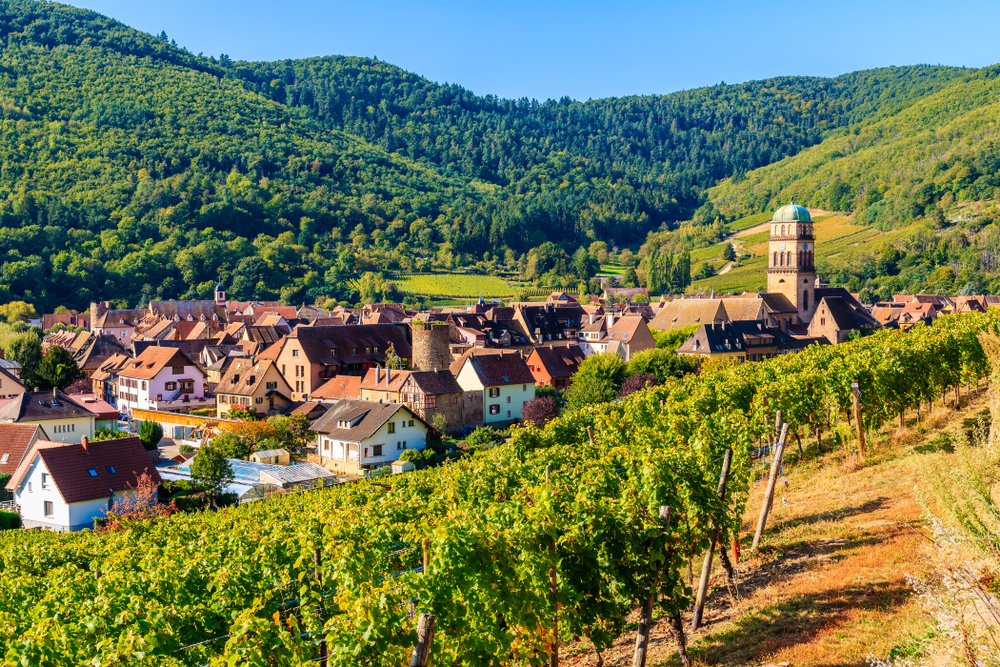The 8,000 km² Alsace in the French region of “Grand Est” on the Rhine and on the border with neighboring Germany can look back on thousands of years of history with many different rulers.
The fertile area, strategically located in the Upper Rhine Plain between the Palatinate and Black Forest, the Vosges and Jura, was already a coveted area 2,000 years ago and at times bitterly fought over. First mentioned in a document at the end of the 8th century under the name “pago alsacense”, Celts, Germans, Romans, Huns, Alemanni and Franks, as well as Germans and French in particular from the 17th to the 20th century, determined the fate and fate of Alsace. Today, visitors can explore and admire the result of this eventful and multifaceted history in the form of world-famous buildings as well as a special, culinary and linguistically special and independent regional culture.
High mountains, dense forests and fertile soils define the enchanting image of Alsace

In terms of landscape, Alsace is characterised by the flat plains in its centre, which are primarily used for agriculture and livestock breeding, and in many places slightly hilly plains, the Rhine River in the east and the Vosges low mountain range in the west, which is up to a good 1,400 metres high. Outside the largest cities and conurbations such as Strasbourg and Mulhouse as well as Colmar, Thann and Wissembourg, Alsace is still very rural and only quite sparsely populated. Numerous charming hiking trails run through the Vosges Mountains and the two nature parks “Ballons des Vosges” (2,700 km²) and “Vosges du Nord” (1,276 km²) around their highest mountain, the Grand Ballon (1,424 metres).
Well-known and well-used hiking routes lead equally through the 21,000-hectare Sainte/Hagenauer Forest (Forêt Sainte/Forêt de Haguenau) between Pfaffenhoffen, Bischwiller and Seltz in the Bas-Rhin department in Lower Alsace. Imposing and impressive, but also relatively challenging, is the three-kilometre-long rock path “Sentier des Roches” between the 1,139-metre-high Col de la Schlucht pass and the third-highest mountain in the Vosges at 1,363 metres, the Hohneck in the canton of Munster.
The traces of the past are omnipresent in many places in Alsace
The eventful and eventful history of Alsace has also left its sometimes sad legacy in the picturesque landscape. For example, on the summit of the Großer Belchen, which is also popular as a ski resort in winter, there is a monument to the mountain infantry battalion “Diables bleus” (Blue Devils), which fought in the First World War. The Silberloch war cemetery on the 957-metre-high Hartmannswillerkopf/Vieil Armand near Mulhouse and Cernay is even one of the most visited tourist destinations in Alsace, with around 2,000 graves for fallen French and unknown soldiers and 250,000 visitors per year.
Also dedicated to the mutual horrors of the First World War in the region are the war cemeteries of Guebwiller and Cernay near Colmar in the Haut-Rhin department. Even older are the remains of the Canal de Vauban/Rouffach, built between 1698 and 1702 near the former fortress town of Neuf-Brisach, which has been preserved almost true to the original, the ruins of the castles of Haneck (Soultzbach-les-Bains) and Landskron (Leymen) as well as the Jewish cemeteries in Hégenheim, Herrlisheim-près-Colmar and Thann.
Magnificent historic churches and monasteries attract holidaymakers interested in culture

However, by far the most famous and most visited cultural monument in the region is the Cathedral of Our Lady in Strasbourg, built from the 12th to the 15th century, which is located in the middle of the almost 200-hectare UNESCO World Heritage Site “Grande-Île and Neustadt” in the center of the Alsatian capital. The Roman Catholic church, built of pink sandstone in the Gothic and Romanesque styles, was often severely damaged by wars over time, but was always rebuilt.
Particularly worth seeing are the main portal on the west façade, the colourful leaded glass windows and the “Epiphany Clock” from 1353 in the southern transept. Fantastic views over the city, the Rhine as well as the Black Forest, the Jura and the Vosges are offered in clear weather by the tower platform at a height of 66 metres on the north tower of the sacred building. Other historic churches in Alsace that are worth seeing include the 12th-century parish church of Sainte-Foy in Sélestat, the 9th-century monastery of Marmoutier and the Collégiale Saint-Martin from the 15th century in Colmar. The Unterlinden Museum in the capital of the Haut-Rhin department also houses the legendary Isenheim Altarpiece from the early 16th century.
The best way to discover Alsace is by taking tours on holiday routes
Travellers can get to know a rich selection of over 100 important monuments in Alsace on excursions on the “Route Romane d’Alsace” (Romanesque Road), which opened in 1999, from Altenstadt (Wissembourg) via 19 stations to Feldbach near Altkirch im Sundgau near the Swiss border. Similarly informative are trips along the “Route des Vins d’Alsace” (Alsace Wine Route), which was established in 1953 and is now 170 kilometres long, from Marlenheim in the northern Département Bas-Rhin through numerous renowned Grand Cru sites to Thann in the southern Département Haut-Rhin.
Along the route, which can also be completed in selected sections, there are not only numerous traditional wineries where you can taste famous wines of the area such as the white wine “Edelzwicker” and the sparkling wine “Crémant d’Alsace”. The large documentation centre with permanent exhibition and viticulture school “Maison des Vins d’Alsace” in Colmar is also recommended to visitors interested in fine wines. In the approximately 120 cities and municipalities, there are of course also many time-honoured inns, restaurants and inns where typical Alsatian specialities such as “Flammekuech” (tarte flambée), “Köjelhopf” (Gugelhupf) and the very hearty Alsatian “national dish” “Sürkrüt/Choucroute” (meat platter with sauerkraut) are served


